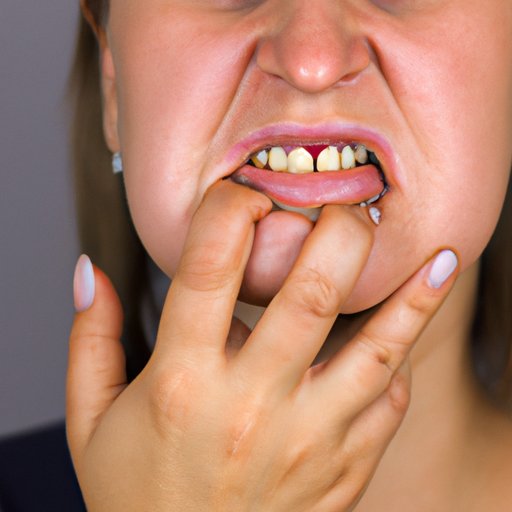
Introduction
An overbite is a dental condition that occurs when the upper front teeth overlap too much onto the lower front teeth. While an overbite may not seem like a serious issue, if left untreated, it can lead to various dental problems, including tooth decay, gum disease, and jaw pain. Fixing an overbite is essential to prevent long-term health issues and to improve oral health and appearance.
Orthodontic Treatment
Orthodontic treatment is the most common method for fixing an overbite. A trained orthodontist can recommend the most effective treatment plan based on the severity of the overbite. The most common devices used to fix an overbite include braces, aligners, and headgear.
Braces involve attaching metal brackets to the teeth and using wires and rubber bands to shift them into a more suitable position. Aligners work by using clear plastic trays to apply gentle pressure to move teeth into their correct position. Headgear is a device worn outside the mouth that applies pressure to the teeth, guiding them into the proper position.
The length of orthodontic treatment varies based on the severity of the overbite. On average, treatment lasts between 18-36 months. During the process, you can expect to feel mild discomfort and some pressure after each adjustment.
Jaw Surgery
In some severe cases of an overbite, jaw surgery may be the best option. Jaw surgery involves moving the jawbone into a more appropriate position to correct the bite. This type of surgery is usually a last resort for those with severe cases of overbite, and it requires careful consideration to determine if it is necessary.
The surgical procedure requires an incision in the mouth to access the jawbone. The bone is then precisely cut and repositioned using small, specialized screws and plates to hold it in its new position. While the procedure may seem daunting, the results can be life-changing for those who opt for this option.
As with any surgical procedure, risks exist. Possible complications include nerve damage, bleeding, and infection. However, these risks are low when performed by qualified professionals. Recovery time from jaw surgery can take several weeks, and a soft food diet is typically required.
Exercises
There are several exercises that dentists recommend to help alleviate an overbite. These exercises can be done in the comfort of your own home, and when done regularly, can help to adjust the position of the teeth and jaw.
One common exercise is known as the tongue press. This entails pushing your tongue against the roof of your mouth and holding it for six seconds. Repeat this exercise 10 times daily. Another popular exercise for improving overbites is the chin tuck. This involves placing your finger on your chin and pushing it back towards your neck. You can do this exercise while sitting or standing and should repeat it 10-15 times each day.
The frequency of exercises can vary depending on the severity of the overbite. It is essential to consult with your dentist or orthodontist for specific recommendations regarding your needs.
Dietary Changes
The food you eat can have an impact on your oral health and the development of an overbite. Certain foods can contribute to an overbite, while others can help promote proper jaw development.
Foods that can cause or worsen an overbite include sugary drinks, hard candies, and sticky foods. These types of foods can damage your teeth and make it more challenging for your jaw to develop correctly. A diet rich in calcium and Vitamin D is recommended to promote dental health.
Foods that can improve an overbite include raw vegetables and fruits as they require more extensive chewing. This extra chewing can help exercise and strengthen the jaw muscles, promoting their development.
Alternative Therapies
In addition to traditional treatment options, several alternative therapies may help with the symptoms and treatment of an overbite. These therapies include chiropractic care, craniosacral therapy, and myofascial release.
Chiropractic care involves the use of manual adjustments to alleviate pain and improve joint function and mobility. Craniosacral therapy is a gentle form of massage that focuses on the bones of the skull and spine. This therapy can help promote relaxation and improve overall wellness. Myofascial release is a type of massage that targets the connective tissue in the body and can improve muscle health and mobility.
While alternative therapies may have potential benefits, they should be used in conjunction with traditional treatment options and under the advice of a medical professional.
Maintenance
Regular dental checkups and proper oral hygiene habits are essential for maintaining a healthy mouth. For those with a history of overbite, it is recommended to see a dentist or orthodontist every six months to monitor the condition. Proper oral hygiene habits, such as brushing twice a day and flossing, can help prevent the issue from returning.
Conclusion
An overbite may seem like a minor dental issue, but the long-term consequences can be significant. By taking proactive steps, such as orthodontic treatment and exercises, dietary changes, and alternative therapies, you can improve and maintain your oral health. It is essential to speak with a qualified professional to determine the best course of treatment and maintenance for your individual needs.
If you are experiencing an overbite or any other dental issues, we encourage you to seek help from a dental professional. Taking care of your oral health is vital for overall wellness and quality of life.





